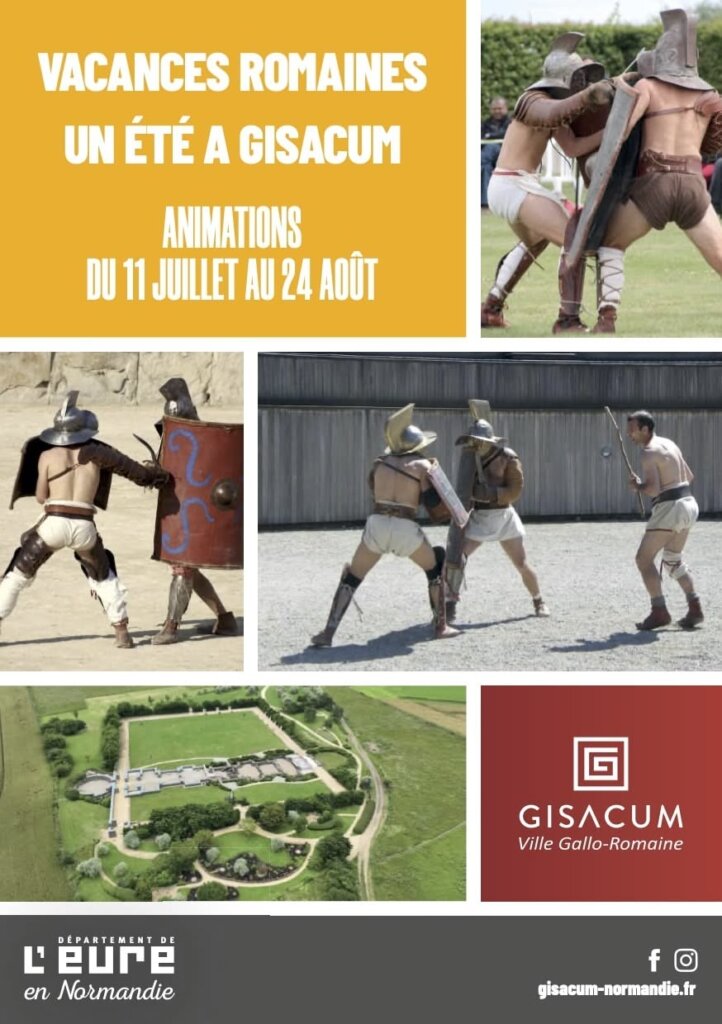A history of the sanctuary town
Some two thousand years ago, the Aulerci Eburovices, a Celtic tribe, founded two complementary towns: Mediolanum Aulercorum (now Evreux), which functioned as a political and economic capital, and the religious town of Gisacum, 7km away.
The sanctuary town of Gisacum appeared in the early first century AD in the form of two residential districts built around a primitive sanctuary and market place. In the early second century, these districts were demolished and a major architectural programme was commenced. The town of Gisacum became a very large city, covering 230 hectares. Its highly innovative town planning involved separating public and private buildings.
Major monuments were located away from residential areas; these were relegated to the outskirts along a road forming a hexagon, beneath which an aqueduct had been installed. The hexagonal shape of this 5.6km long ring road is unique in the Roman world, and makes the sanctuary town one of the largest in Gaul, covering some 230 hectares. All the houses were built along this road encircling the town, facing inwards towards the monumental centre and sanctuary.
The monumental town centre was wholly given over to monumental public buildings: the baths (now developed as an archaeological garden), the large sanctuary, the theatre, marketplace and other temples.
The town had its heyday between the middle of the second and third centuries before suddenly being abandoned.
The main monuments at Gisacum
Although today only the baths have been developed and are open to the public, in the third century the town of Gisacum was composed of a large number of public monuments discovered through archaeological digs and certain surveying methods.
A monumental centre
The monumental centre comprises the central avenue formed by the baths, sanctuary and theatre, in addition to which there was a marketplace. All of the town’s three main monumental buildings – the baths, temple and theatre – are linked to its religious function. When religious feasts were celebrated at Gisacum, pilgrims from all over the region would travel to the baths, before going to pay tribute to the gods and watch a play, doubtless with a highly religious theme.
The baths
The baths were a very important building in the daily life of Gallo-Romans: people came there to wash, practice sports, take a walk, talk business, have a bite to eat or prepare to visit the sanctuary. This meant that they played an important role in people’s social life and in the everyday life of Gallo-Romans as a whole.
The Gisacum baths are arranged in three parts: the courtyard area surrounded by latrines, the pool, and the palaestra, surrounded by a columned gallery or portico.
The courtyard area was a space for storing the equipment required to operate and maintain the baths. This work was carried out by slaves.
The pool was a place for bathing and body treatments, comprising two symmetrical parts along either side of the central heating room. Each pool area comprised a changing room (apodyterium), a cold room (frigidarium), two warm rooms (tepidarium), and a hot room (caldarium).
The palaestra was a large open-air area for sports. A range of disciplines were practised there, including wrestling, shot put and ball games.
The sanctuary
The sanctuary was the town’s principal monument. This building, located at the very centre of the town, was enormous: the consecrated enclosure covered between 6 and 8 hectares and the temples towered 25m high, dominating everything else.
The most recent form of the sanctuary comprised three main temples, probably dedicated to Apollo Gisacus, a bull god who was believed to protect the town, Jupiter, and a third as yet unknown god.
In addition to this large main sanctuary, there were two other typically Gaulish temples (or fana) in the town, close to the baths and marketplace, offering further confirmation of the religious function of the town.
The theatre
Less is known about Gisacum theatre, but ancient plans and geophysical surveys have helped us understand its layout.
An excavation campaign conducted in 2010 allowed the three phases in the building’s construction to be more clearly identified. It had a diameter of 106m, making it quite a large building for Gaul.
The monumental entrance was more or less in line with the temple, allowing direct access to the arena (orchestra). This indicates that the ceremonies and plays that took place there were probably distinctly religious in nature. It is believed that this building had a capacity of 7000.
The forum
The monumental centre also had a marketplace comprising a number of squares or yards surrounded by buildings. It is traditionally believed that the forum was the centre of the political, administrative, social and economic life in capital cities, although Gisacum did not have this status. The fact that it was close to the capital Evreux and the scenario of a twin city suggest that some municipal activities were moved to Gisacum during major religious feasts there.
The whole town was supplied with water by means of a 25km-long aqueduct that took water from nearby Damville, dividing into a number of branches on arrival in the town to supply the houses and public monuments.

















